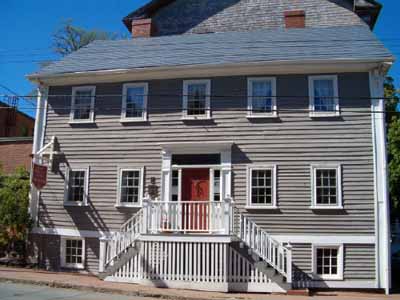Knaut-Rhuland House National Historic Site of Canada
Lunenburg, Nova Scotia

Façade
© Tourism, Culture and Heritage, Province of NS/Province de N-É, 2004.
Address :
123 Pelham Street, Lunenburg, Nova Scotia
Recognition Statute:
Historic Sites and Monuments Act (R.S.C., 1985, c. H-4)
Designation Date:
2002-11-01
Dates:
-
1793 to 1793
(Construction)
-
1986 to 1986
(Alteration)
Event, Person, Organization:
-
Benjamin Knaut - merchant
(Person)
-
Conrad Rhuland - mariner
(Person)
Other Name(s):
-
Knaut-Rhuland House
(Designation Name)
Research Report Number:
2002-002
Plaque(s)
Existing plaque: 123 Pelham Street, Lunenburg, Nova Scotia
This attractive house, built around 1793, is one of the best early examples of British classicism embodied in a residence in Canada. Its balanced proportions and formal decorative detailing are a precursor of more elaborate homes designed in later decades. The centre-hall plan and classical motifs of the interior reflect the harmony of the exterior. The building is named for its first two owners, the merchant Benjamin Knaut and the mariner Conrad Rhuland.
Description of Historic Place
Located in the centre of downtown Lunenburg, the Knaut-Rhuland House National Historic Site of Canada, is a severely formal wood frame house of classical inspiration. Built flush to the street, this vernacular clapboard home is given an air of grandeur by the split staircase accessing the central entry. The designation refers to the interior and exterior of the house on its legal property.
Heritage Value
The Knaut-Rhuland House was designated a national historic site of Canada because: it is one of the best preserved examples of British classicism applied to a residence by virtue of its precise, harmonious design and rich detail; and it is an early example of British classicism illustrating the lineage of later prestigious homes, of either Palladian or Neoclassical style, which flourished in Canada in the years that followed.
This attractive house, built around 1793, is one of the best early examples of British classicism embodied in a residence in Canada. Its balanced proportions and formal decorative detailing are a precursor of more elaborate homes designed in later decades. The centre-hall plan and classical motifs of the interior reflect the harmony of the exterior. The building is named for its first two owners, merchant Benjamin Knaut and mariner Conrad Rhuland. Minor modifications over the years adjusted the layout according to contemporary needs, including its brief subdivision into two apartments. Save for the addition of modern wiring and plumbing, these changes were reversed in the 1980s and the house is now operated as a historic site, open to the public.
Source: Historic Sites and Monuments Board of Canada, Minutes, April 2003.
Character-Defining Elements
Aspects of this site which contribute to its heritage value include: those elements which speak to this early version of British classicism in Canada, namely its cubic massing, symmetrically organized elevations and floor plan, central main entrance, evenly spaced, relatively small window openings, and simple, classically inspired wood detailing, specifically the sash windows and mouldings, returned eaves, and decorative corner boards; those elements which speak to its state of preservation, including the surviving wood construction with exterior clapboard cladding and wooden window and door surrounds, particularly its central entry door with sidelights and elliptical fanlight, its surviving original interior layout with wooden fireplace surrounds and wood mouldings.